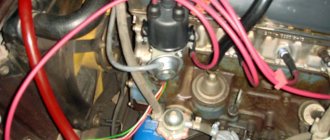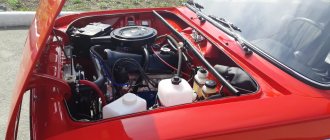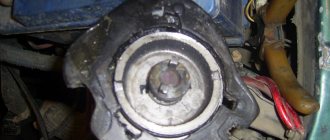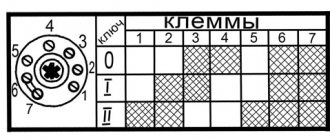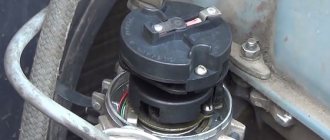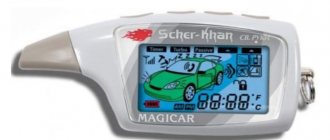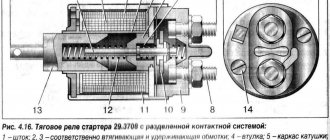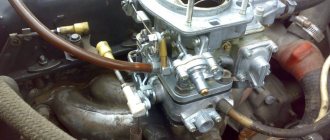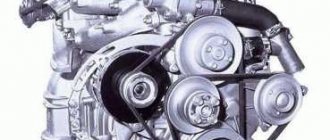The ignition advance of the fuel-air mixture on a gasoline and diesel engine is the ignition of the working mixture in the cylinder at a strictly specified moment. This moment should be understood as the piston being at TDC.
Correctly set ignition timing greatly influences the proper operation of the engine. Deviations lead to loss of power and unstable operation of the internal combustion engine. In a four-stroke engine, the mixture ignites at the end of the compression stroke and also before the piston reaches top dead center.
What is ignition timing and why is it needed to be adjusted?
In the operation of an internal combustion engine, it is important that the fuel mixture is burned at a certain point in time. When the piston position is at the top point, the spark plug gives a spark and the combustion process occurs. It pushes the piston and causes the crankshaft to rotate. The ignition timing is a certain degree of TDC (top dead center) position. If it moves, then ignition will occur earlier or later than the required time.
Today, cars use different types of powertrains. There are certain calculation methods for each type and, accordingly, instructions for setting the correct ignition timing. The adjustment is made using a strobe or control lamp. Depending on the type of fuel and engine model, the advance angle is set differently.
Tip: Before starting work, make sure that the instructions are suitable for your car model and type of power unit.
Functions of the internal combustion power unit
Before turning your attention to the ignition angles, you need to find out the operating features of the entire vehicle structure. Of course, ignition timing plays a huge role in the basic functions of engines. It occurs when the piston reaches the top mark at the moment of compression. As a result of this small explosion, the gases can easily expand, and at the same time the piston will continue to move and make its working stroke.
Piston at TDC
Despite the fact that such processes arise and proceed at a rapid pace, they still require some time to be spent. As for the crankshaft, it also produces some rotations at high speed, and based on this, the piston can quickly go some way from the moment the mixture ignites until the gas expands. It is worth paying attention to the fact that when ignition occurs when the piston is at TDC, then combustion occurs at the beginning of the power stroke, and the process will end a little later. Due to this, the gas pressure indicator is reduced.
Ignition timing
But what to do if the combustible mixture tends to ignite ahead of time, then the gas pressure reaches its maximum point before the piston reaches its highest point. This state of affairs means that there is some opposition to its movement. These parameters will negatively affect the functioning and general condition of the power unit, so ignition timing control is a very important process.
How to set the ignition correctly
Before setting the ignition, you need to remember that when carrying out any installation work on the car, all removed parts must be cleaned of dirt and grease. It would also be a good idea to clear the scale, and to make it easier to read the indicators, mark the central mark corresponding to TDC with a white marker.
Do not wear clothing that could get caught between components under the hood.
All internal parts of the distributor are kept under voltage by the ignition system. If the distributor is faulty, attempting to adjust the spark plugs may result in electric shock. The vehicle's parking brake must be set to prevent it from rolling away.
DIY adjustment
Each driver can adjust the settings of the described system independently. To set the ignition timing you will need the following tools:
- Strobe. Moreover, it doesn’t have to be some kind of “sophisticated” one, maybe a simple one that doesn’t have a built-in tachometer and is inexpensive. A more advanced one, which is distinguished by the presence of a built-in tachometer, costs more accordingly.
- Tachometer. In this case, you can use the devices built into the dashboard, as well as connect external devices (for example, a multimeter or autotester in tachometer mode) and focus on sound signals. The latter is recommended to be carried out only if you have considerable experience in this matter.
- Open-end or socket wrench. An alternative option is an L-shaped wrench or a ratchet head. But the optimal size is about 10.
- Slotted screwdriver.
So, answering the question of how to set the ignition timing, first we should note the importance of the preparatory work. So, I advise first:
- Warm up the engine to about 90°, that is, to the optimal operating temperature, and set the idle speed to a minimum level (this is about 800 per minute). To carry out the last action, you need to rotate the screw responsible for the amount of fuel mixture and located on the carburetor.
- You can set this minimum number of revolutions by ear or using a tachometer - whichever is more convenient for you. If they comply with the norm, then this action does not need to be performed.
- Remove the silicone tube from the fitting located on the housing of the vacuum ignition timing regulator on the trembler.
- Check if there is a vacuum in it by placing your finger on its hole. Nothing like this should happen. If this is not the case, then the speed should be gradually reduced until the vacuum disappears. To do this, you need to smoothly rotate the previously mentioned screw.
- Turn off the engine and use a knot or small bolt to remove the hole in the pipe.
- Using a slotted screwdriver, turn the flywheel (before this, carefully unfasten the distributor body by loosening its fastening nuts with a wrench), as a result of which a long transverse alignment mark should become visible.
- Connect the strobe depending on the instructions for it.
To set the ignition timing close to ideal, I recommend following the following instructions:
- Start the engine, and once again check with the tachometer that the speed is minimal.
- Direct the flashing beam from the strobe into the hatch with the scale.
- As a result of this, the highlighted mark, which is placed on the flywheel, should be opposite the required division on the scale.
- Each division on the scale is the corresponding degree of ignition timing.
- To adjust the ignition timing, rotate the distributor housing.
- After the required value has been achieved, disconnect the strobe and securely fasten the distributor.
For a better understanding of the above steps, I recommend also familiarizing yourself with such concepts as ignition timing regulators, as well as its sensor, clutch and ignition timing variator.
So, there are two regulators: centrifugal and vacuum. The centrifugal ignition timing regulator is designed to change this indicator at an automatic level, and this depends on the number of revolutions produced by the crankshaft. The vacuum ignition timing regulator is used for the same purpose, but its activity only depends on the speed of the engine.
The ignition timing can be changed by also changing the crankshaft position sensor data. And a device such as an ignition timing variator can help with this. The use of an ignition timing variator is necessary due to the fact that the burning rate of gas is lower than that of gasoline .
The main feature of ignition timing variators is that they are able to be configured with computer programs and change this indicator with an accuracy of 1 degree. Also, this device does not need to be connected to the pedal and allows you to create a car acceleration schedule. Therefore, an ignition timing variator is a necessary mechanism, which, in addition, can be used as a generator.
We recommend: The best engine cleaners
The ignition timing sensor is also an important mechanism. There are two of them in the car (on top and on the right side), and if they are absent, the engine simply will not be able to start.
And the last mechanism, but not the last necessity, is the ignition advance clutch, the operating principle of which is, as a rule, mechanical. This ignition advance clutch is needed in order to provide better engine dynamics, as well as to advance the ignition of the fuel at higher speeds. As a result, the engine operates more powerfully and efficiently.
Doctrine on fuel assembly combustion
How to check the ignition timing
As many people know, fuel assemblies do not burn completely after ignition. Or rather, it burns out, but not immediately. Moreover, it does not detonate in the engine cavities, as some amateurs believe. The combustion of gasoline is a chemical reaction that has its own speed. And you need to be able to coordinate it with the speed of the piston stroke. This is the method of obtaining the most optimal gas pressure at the required point.
The combustion of fuel assemblies is not just a chemical process, but a whole theory. For example, if you delve into the jungle of this area of science, it becomes clear that with a small spark from a candle, the front of the flame begins to spread. The spark burns for approximately no more than 1 millisecond, and during this insignificant time the temperature reaches the highest Celsius level - 10 thousand degrees. The volume of flammable material that receives the first charge is essentially instantly destroyed. And from this heat the flame front is transmitted throughout the entire chamber (CC).
It has been proven that the initial combustion rate is negligible. But as the flame increases, the speed increases by 70-80 times. Remains of fuel assemblies, which do not disappear completely due to the fact that they are located near the less cooled walls of the combustion chamber, burn out noticeably more slowly. Thus, the entire combustion process takes approximately 30 degrees UPKV (rotation angle of the crank shaft).
At different positions of the SPD, correspondingly different flows occur inside the engine. If the angle is set correctly, the ignition is not disrupted, then the optimal pressure of gases is delivered to the place where the piston passes TDC. According to the degrees scheme – 10-12°.
If the OZ deviates, for example, towards delay, then the most optimal gas force maintains the 45 degree zone, which implies a lower position of the piston. It turns out, as we see from the diagram, that the gases seem to be sent after the piston going down. The efficiency of such piston operation is reduced to almost zero.
It is in such cases, during the process of late ignition, that the fuel assembly burns out after the exhaust valves open. And the hot gases of the exhaust system can easily ignite only the approaching charge of the mixture. This is what causes the popping sounds, which are sent to the air flow distributor.
An unfavorable situation also occurs with early ignition. In this case, the apogee pressure level occurs at TDC or earlier. The gases begin to put pressure on the piston, which has not yet reached its apogee. Obviously, this option will not lead to anything good - the power of the internal combustion engine will noticeably decrease, detonation and other troubles will occur.
Adjusting the ignition by ear
If you don’t know how to set the ignition, you can use the method by ear.
To search for an ignition spark in this way, you need to start the engine and warm it up; the procedure is carried out with the internal combustion engine running:
- First, you should loosen the nut that secures the distributor body, then the assembly must be rotated in different directions.
- At the moment when the engine speed is at its highest, you should apply gas. If there are no interruptions, shots or pops when you press the gas, this indicates that the position has been found.
- From this point, you need to rotate the distributor body a few degrees clockwise, and then fix it in this position. This must be done so that the set angle is not too early. It happens that setting the ignition timing is impossible as a result of using low-quality gasoline or some problems in the operation of the fuel system.
Ignition: late and early
Which ignition is better? An experienced motorist or expert will immediately say: optimal. And in itself, late or earlier ignition is already extreme, capable of giving the car owner a lot of headaches.
The stability of the operation of an injection engine directly depends on proper adjustment of the ignition system. This will help increase the power of the internal combustion engine, reduce fuel consumption, and improve efficiency.
Ideally, on a 4-stroke internal combustion engine, the fuel assembly should ignite at the end of the compression stroke. This means that the fuel must ignite at the very moment when the piston reaches TDC. This process is due to the nuance that the fuel assembly needs a specific time to burn, after which the resulting force will push the piston down.
So, late or early ignition implies a delay or advance in the operation of the above process. In other words, the ignition system is configured so that a spark is formed and ignites the fuel assembly not at the optimal moment for this. This happens sooner or later.
It is not difficult to determine if the ignition setting is not optimal. Engine malfunctions observed periodically are evidence of this. You can also study the main signs that determine an incorrectly set ignition.
- If there is unstable operation of the power unit in idling mode.
- Starting the internal combustion engine is clearly difficult.
- Fuel consumption has increased.
- The responsiveness of the accelerator pedal is not as impressive as before.
- The engine often overheats and detonation occurs.
- The power of the power unit decreases, it loses throttle response.
In addition, an incorrectly set OZ leads to popping noises that radiate into the intake system. Further operation of a vehicle with a crooked OZ is impractical and leads to more serious problems with the power unit. This is especially dangerous if detonation is noticeable.
| Symptoms and signs of pre-ignition | Symptoms and signs of late ignition |
| Excessive detonation (piston defect, destruction of connecting rods). | Loss of power. |
| A clearly audible knocking sound in the engine (increased wear). | Poor starting (which causes the battery to suffer). |
| Loss of power (especially noticeable at low speeds). | Increased fuel consumption. |
| Increased fuel consumption. | Engine overheating (may even seize). |
The difficulty of determining ignition on fuel-injected internal combustion engines is due to the fact that everything depends on the electronics. In this case, the problem must be solved not by mechanical intervention, but by configuring and programming the ECU.
It is noteworthy that on used cars, various errors accumulate in the ECU memory over time. The latter can lead to firmware failures and improper functioning of the engine and ignition systems. To identify and reset detected errors, you will need, as mentioned above, to use special software.
Instructions for installing UOZ on different engines
The ignition timing can be set on various types of engines, whether carburetor or injection.
This is interesting: A unique 900-horsepower hypercar from Italy will be shown in Shanghai
How to set if you have a distributor
Since in our country there are a large number of owners of VAZ 2108 - 2109, which use carburetor engines with a distributor, it is worth starting with them. From the working tool we will need:
- strobe;
- tachometer (autotester or multimeter in tachometer mode);
- ring and open-end wrenches.
The adjustment must be made on a warm engine to a temperature of 85-90 degrees. Next, set the minimum speed to 800 rpm.
- From the ignition timing regulator, remove the tube that fits from the carburetor.
Remove the tube that goes to the UOZ regulator
- By placing your finger on the hole, we check the vacuum and, if necessary, reduce the engine speed.
- We turn off the engine.
- We close the hole on the silicone tube with a bolt of suitable diameter.
- We press out the three nuts on the distributor body using a wrench.
We press back the nuts on the distributor so that it can be rotated.
- There is a special scale with marks on the gearbox housing. If it is closed with a rubber stopper, remove it.
The adjustment will be made on a scale with marks that shows the ignition timing
- Using a screwdriver, set the flywheel to 0 degrees (when the long mark is opposite the triangular cutout on the scale).
- We connect the strobe as shown in the diagram.
We connect the strobe according to the diagram
How to set ignition timing on a carburetor engine
The adjustment process is as follows:
- We start the engine and control the speed using a tachometer.
- We direct the strobe beam to the scale with marks.
- We set the required angle for the brand of gasoline used.
For A-92 gasoline, the advance angle is +- 1 degree. For A-95 +-4 degrees. Each division on the scale represents 1 degree.
- We set the position of the distributor to the desired degree by simply rotating it clockwise or counterclockwise.
- After completing the adjustment, turn off the engine and secure the distributor by tightening the nuts.
How to make the adjustment correctly (video)
How to adjust on the injector
Most modern models are equipped with injection systems that are controlled by an on-board computer. In this case, for adjustment you will need a laptop with a special program. A violation of the safety regulation can be determined by the warning light on the instrument panel coming on.
This is interesting: About changing gears without a clutch
The adjustment process itself is the same as in a gasoline engine. The main difference is the absence of spark plugs. The algorithm is as follows:
- Removing the decompression mechanism.
- Dismantling the engine meter and the neck housing.
- Checking the oil supply level by moving the lever to its extreme position.
Tip: In addition to the adjustment itself, it is necessary to measure the voltage of the on-board network and the sensor. Normal voltage is considered to be 0.45-0.55 V for the sensor and 220 V for the network.
Working with diesel
With diesel engines everything is much the same. One has only to say that the concept of “ignition timing on a diesel engine” is not entirely correct in terms of terminology. On a diesel engine with an injector, you can adjust the timing of fuel injection. The operation of non-injection diesel engines is associated with the normal functioning of the injection pump (high pressure fuel pump).
We especially note that manual adjustment of the ignition timing of injection engine types is not recommended for novice motorists, since handling the programs requires certain skills, sometimes expert ones. Don't damage the car!
The process of adjusting the ignition timing is not as complicated as it might seem at first glance. The main thing is to know what degree you need to set for the fuel you are using. The adjustment itself takes little time, you just need to do the work according to the instructions and in the correct order.
Tools and Diagnostics
Tools are an important part of any job. They will be needed to make adjustments to the process of issuing SOP. Mandatory tools include screwdrivers, a measuring instrument, wrenches, and preferably a laptop with a specially installed program designed for diagnosing injection-type power units.
First, you should know that on an injection engine, electronics are responsible for driving the car. It is subordinate to the head – the computer system. Conducting quality testing of all components of the injection system is the first thing to do.
Here's how it's done:
- the ignition is turned on;
- the supply of fuel by the electric fuel pump is checked (the characteristic sounds of activation of the pump performing the injection should be heard).
If there are no sounds of the fuel pump operating, you need to check the relay that controls the operation of the pump.
Check UOS with a laptop
You should also pay attention to the instrument panel, on which the indicator may indicate. If this is the case, then you need to connect a laptop with a special program to the BC system. It will help you analyze errors and display them in a list.
If no problems are identified at this stage, then it’s time to start the internal combustion engine. On a functioning engine, the throttle assembly is checked first.
Here's how it's done:
- first, an external inspection of the sensor, which is responsible for the position of the damper, is carried out;
- then the wiring condition is tested;
- if everything is in order, it would not be superfluous to measure the voltage of the entire circuit and sensor using a measuring device;
- the obtained values must be compared with the standard indicators specified in the vehicle repair manual.
A normal current value can be considered to be in the range of 0.45-0.55V. The current value should not exceed 12 V, and the throttle opening degree should not be more than 1%. If deviations are noticed, then you need to adjust the throttle drive so that it closes the damper entirely.
Next, you need to press the gas pedal all the way, re-measuring the indicators this way. The damper open level should be 90%. As for the sensor voltage, the voltage must be 4.5 V.
Throttle actuator tuning is considered an important part of the work included in the diagnosis. It allows you to simultaneously set up a node and check the consistency of the values.
In order to adjust the drive you need to:
- disable the RDPV (sensor responsible for additional air flows);
- half open the throttle;
- make adjustments so that the damper completely covers the hole.
What equipment will you need?
A complete list of required equipment is presented below:
- crooked starter or ratchet wrench;
- a flat-head screwdriver equipped with a wide, powerful blade;
- open-end wrench 12×13;
- a set of different probes;
- rubber cone plug;
- spark plug key;
- vehicle operation and repair manual from the manufacturer;
- strobe;
- protective gloves and closed shoes;
- surface degreasing agent and lubricant;
- cloth rags and paper towels.
Checking the settings
To check what ignition timing was set and whether it is correct, you need to be guided by the following signs:
- No “dips” in the operation of a warmed-up engine should be felt when it is idling.
- A short detonation (about 3-5 seconds) should be present if you sharply press the gas pedal, and the movement should take place on the most flat section of the road in fourth gear and a speed of about 50 km/h. In other words, the sound of fingers should be heard. If this is not observed, then the ignition was set too late, but if this is present, but cannot go away, then the ignition is too early. The situation can be corrected by small rotations of the distributor in different directions, after which the check must be done again until optimal results are obtained.
Ignition timing is undoubtedly an important phenomenon in the overall picture of a car’s operation. Jokes and an irresponsible attitude towards this can lead to a quick breakdown of the entire iron unit. So keep an eye on this process.
Why does the OZ go astray?
Such situations occur quite often. The standard parameters are lost because they are not suitable for specific operating conditions. And here the OZ must be adjusted independently, manually.
Why does the OZ go astray?
However, you should first check whether the intervention procedure is really necessary. As was written above, to test the correct OZ, the car needs to be accelerated on the highway to 35-45 km/h, then sharply press the accelerator pedal.
If short-term detonation noise occurs and strong acceleration occurs, you don’t have to do anything with the OZ. The angle is set correctly, everything is clear. You can also verify this if detonation disappears after the speed mark of 60 km/h.
Otherwise, if the detonation sound does not stop or the car does not accelerate, this indicates a faulty ignition. The first option - the OZ is set to an early moment, in the second - to a late moment. And accordingly: you need to rotate the distributor against the movement of the slider or in the direction of its rotation.

